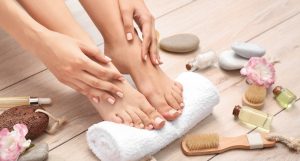Skin
Microneedling: Everything You Need To Know & How To Do It At Home
As its name suggests, microneedling is a procedure that requires micro needles poking into your face. Yes, it can sound...
By: Cherelle Lim / May 27, 2021

As its name suggests, microneedling is a procedure that requires micro needles poking into your face. Yes, it can sound a bit scary because who would want needles in their face! Well, this is because microneedling can help treat several skin concerns such as stretch marks, wrinkles, acne scars and fine lines. Since it provides these benefits, most people will opt for either professional or at-home microneedling. Doing it at home means you are going to use a derma roller. This at-home method also tends to be gentler as the derma roller doesn’t penetrate the skin too deeply. At Beauty Insider, we will let you know how you can perform microneedling at home and learn more about it.
Contents
What Is Microneedling?
Now, the big question. What is microneedling? Microneedling is essentially using a device such as a derma roller on your face. These devices tend to look like a paint roller, except they are covered with metal spikes. Yeah, doesn’t sound too promising. But, we promise it is actually beneficial! Microneedling helps with stimulating the production of collagen and getting your skin to start its natural healing process. It achieves this as the little needles puncture your skin and pierce tiny holes all over your face. Although this may sound like a scene from a slasher movie, we guarantee that there will be no bloodshed! Besides, at-home microneedling is less intimidating than it sounds.
Professional VS At-Home
The difference between professional and at-home microneedling is mostly the device used. In a professional setting, they tend to use a battery-operated device. This device is electronic and resembles a pen. If microneedling is done by a professional, they also use needles that are longer. This way, they can penetrate your skin much deeper to help treat skin damages such as wrinkles and acne scars.
If you are performing microneedling at home by yourself, the device seems much simpler. It is a derma roller that you would just roll onto your skin. Since a derma roller has small needles, you probably won’t feel much pain. It would just be a tiny prick! Although, at-home devices such as derma rollers will not penetrate your skin deep enough to help treat wrinkles or scars. But, it does have the benefit to help improve your skin’s texture! Besides that, at-home treatments penetrate just enough to help stimulate the epidermal growth factors of the skin. Thus, it helps promote collagen and help other topical products absorb better.
Who Needs Microneedling?
Performing microneedling may be sensitive for some skin types. Therefore if you are doing it by yourself at home, it is always important to pick the right products. It is also crucial that you follow the instructions given. So, who needs microneedling? Well, if you are looking to boost the glow of your skin or tackle ageing signs, you would get the most benefits. If your skin is a bit more on the sensitive side or if you have severe acne, it might not be a good idea to do microneedling. This is because it could end up spreading bacteria and cause inflammation to worsen. If you notice any side effects when doing at-home treatments, you should stop immediately. Overdoing it is not ideal either.
The Benefits Of Microneedling
There are several benefits microneedling can offer. It has the benefit to help with fine lines, improve skin tone and even give a boost of hydration. Although at-home treatments might not give dramatic results like done at a professional’s, they still can help to enhance exfoliation! Besides that, it also helps your skin better absorb other skincare products. Besides giving your face a skinning glow, it also helps boost collagen too! If you do visit a professional for microneedling, there would be more benefits of improving acne scars, stretch marks and even wrinkles. With consistent use, however, some users have seen improvements with their skin.
How Do You Do Microneedling At Home
Now performing microneedling at home means more care is needed. Thus, here is your guide on how to do it properly on your own!
1. Clean your derma roller
Before you start rolling needles all over your face, it is important to disinfect your tools first. Poking needles into your face is already scary enough, you don’t need an infection from a dirty derma roller! Therefore, soak your derma roller in 70% isopropyl alcohol for around 5 to 10 minutes.
2. Wash your face
Next, after you have cleaned your tool for microneedling, you need to clean your face! Wash your face with a gentle cleanser that has a balanced pH level. After cleansing your face, apply some of the isopropyl alcohol onto your face before beginning to roll. If you are sensitive to pain, it might be helpful to apply some numbing cream after cleansing your face.
3. Start rolling on your face
Now, we finally begin after prepping your face and tool. It is a good idea to make a mental note as you divide your face into 4 sections. Avoid the areas of your eye and section into – upper left, upper right, lower left and lower right. Now, start rolling, one area at a time in one direction. Either vertically or horizontally, roll gently but firmly. Lift your derma roller each time you roll and do it 2 to 3 times. After rolling vertically, be sure to go back again on that same section, but this time roll it horizontally. Or whichever way you didn’t do it first!
4. Rinse your face & clean your tool
Lastly, you need to wash your face and your derma roller. Rinse your face with clean water and dry it with a clean pad. Wash your derma roller with dishwasher soap and soak it in 70% isopropyl alcohol for 10 minutes. You should also change your derma roller occasionally after 10 or 15 uses. So you should change it every month if you use it several days a week.
Aftercare
After you have done your microneedling, you can apply your other skincare products and it will help absorb better. Thus, it is great to apply some serums after to help give your skin a hydration boost! Besides that, microneedling has helped open up your skin so the serum will be better absorbed. So if you are applying a serum after, you should look out for those with ingredients such as vitamin C, hyaluronic acid, peptides and growth factors.

















